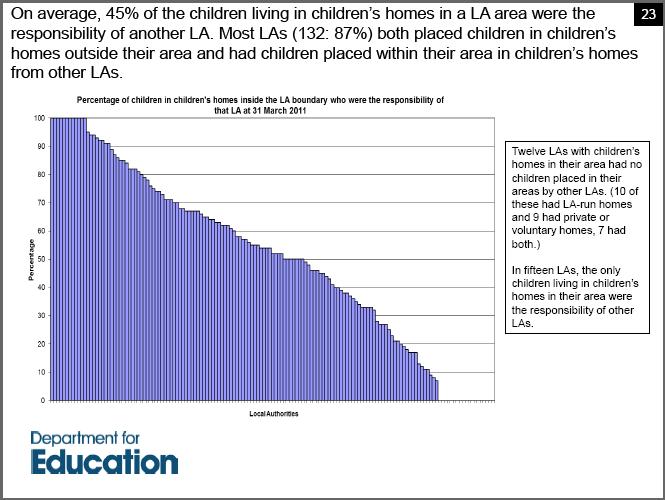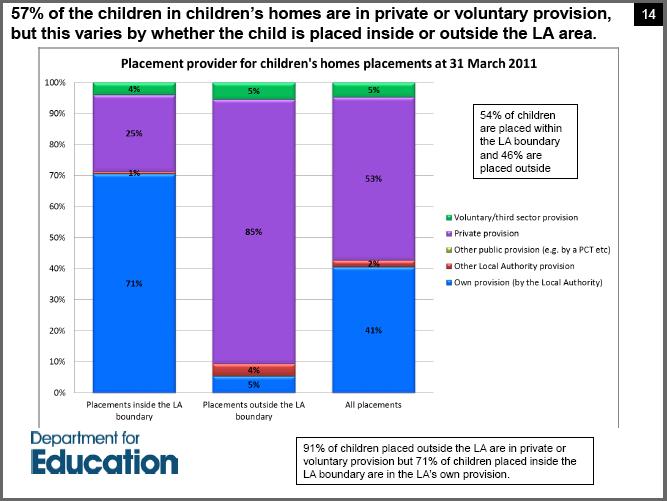Do nearly half of children in care live outside the local authority responsible for them?
'About 45% of children in care live outside the local authority that has responsibility for them.'
The Guardian, 3 July 2012
The government this week announced plans to tackle child sexual exploitation in care homes across England.
In May, nine men were found guilty of grooming and exploiting young girls in Rochdale. One of the victims was in care at the time.
Following the recommendations of an accelerated report by Deputy Children's Commissioner Sue Berelowitz, the government will implement a number of measures. This includes new regulations that will make it harder to place children in care homes outside their local authorities.
Analysis:
The Guardian's claim can be traced to the Deputy Children's Commissioner's report: Inquiry into Child Exploitation in Gangs and Groups, with a special focus on children in care. The report claims that, on average, 45 per cent of children living in children's homes live outside the Local Authority which has primary responsibilty for them.
The reasons for this are made clear in the report:
"Local authorities (LA) in the North West of England have the highest number of providers and places in the country. Several English LAs have no children's homes within their geographical area and it has become relatively common practice for those LAs who have children needing a place in a care home to place them outside their local authority boundaries."
The 45 per cent figure refers to statistics compiled by the Department of Education's data pack on children's homes in England, March 2012.
Slide 23 of the pack provides the necessary information suing data gathered from local authorities:

Only a small minority (12) of the authorities had no children in children's homes within their borders who were under another authority's responsibility.
We have asked for a more detailed breakdown of this data, but we have yet to receive a response. However an All-Party Parliamentary Group report published last month points out that in Cheshire, for instance, 'approximately 80% of looked after children have been placed by an outside authority.' This figure was from a written evidence submission by the Association of Chief Police Officers.
For their part, however, the Department for Education provide several explanations of the data. For instance, the point out that all Local Authorities place some of their children in children's homes outside the boundary (shown in slide 22 of their report), and go on to explain:
"This may be because of the specific needs of individual children and indicate demand for more specialised services unavailable locally."
However that's where the more pleasant reading ends. According to the DfE, 40 authorities had too few places to cope with the demand in their local area, and eight had no registered children's homes whatsoever. Moreover, several authorities did not have these deficiencies yet still exported their in-care children.
Furthermore there is evidence that private provision of care accounts for the vast majority of children in care placed outside their local authoirty. Slide 14 indicates moreover that 71 per cent of children placed in the local authority boundary are in the local authorities' own provision:

Conclusion
It is not difficult to trace The Guardian's claim to the data from the Department for Education, although the specifics behind the figures are yet to be made available.
The evidence we do have suggests that there are some apparently good reasons for 'outsourcing' children's home placements for children, for instance when the child is in need of specialised services only available outside the authority.
However the Parliamentary Group's position makes clear that large numbers of children placed away from home still suggests serious failings on the part of local authorities to meet their duties of care.
Update (4 July 2012)
One of our Twitter followers kindly pointed out the distinction between children 'in care' and 'in children's homes' which are different things, for instance children in foster care count as being in care but are not in children's homes.
For this reason, we can't be sure from the data cited in the DfE report of the proportion of all children 'in care' as the figures only account for children in homes. We've updated our article to account for these points.